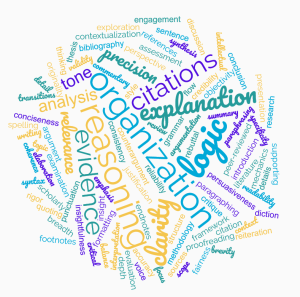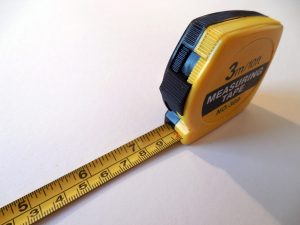Prewriting 1: Understanding the Task
Sometimes, you define the writing task, but in college, it’s more likely that a professor gives you a writing assignment. Either way, if you do not understand the parameters of the project, you will almost certainly struggle with it. When I use the word “parameters,” I am referring to the guidelines of the assignment. Mostly, these will be determined by your professor, but sometimes you have a say in those guidelines.
For your writing assignments, you want to make sure you understand the following:
- The purpose(s) of the assignment
- The audience(s) for the final project
- Technical information such as sources and length
- Your topic
We’ll talk about all of these in this chapter.
Understanding Purpose
What are you supposed to do? And why? These questions are central to any writing task.
Too often, students think about the first question in technical terms: “I’m supposed to write a four-page paper on a significant issue in my hometown.” While the number of pages does matter (and we’ll talk about this kind of technical requirement shortly), there are more significant questions that this kind of simplification doesn’t answer. What are you supposed to say about that issue?
- Are you explaining the issue?
- Arguing for a solution?
- Trying to identify points of compromise?
- Providing a historical overview?
- Something else?
If you don’t understand what you are trying to accomplish in the assignment, you are unlikely to be successful.
Identify the primary purpose
Specific assignments differ, but at the core, we can identify three primary purposes for writing:
- To inform: Informative writing provides information and explanations to the reader.
- To persuade: Persuasive writing works to convince the reader.
- To entertain: Entertaining writing provides the reader with enjoyment.
These aren’t mutually exclusive. Can you imagine a successful argument, for example, without good information to back up the claims? Similarly, information can be persuasive, even if the writer isn’t actively trying to convince the reader of anything. Finally, think about how many novels have been written to make a case for something.
But one of these purposes will be primary. That is, the professor will be most interested in seeing you focus on one of these things. It may be fine for you to do more than one (check with your professor), but one will be more important than the others.
For most college writing assignments, the primary purpose will probably be either to inform or to persuade. Be sure you know which you are being asked to do, and if you aren’t sure, ask your professor.
Find the Verbs
Remember the whole “-ing” discussion at the beginning of this section? Writing is an action, and verbs are action words. Examining the verbs in an assignment can help you understand its purpose. What, exactly, is your professor asking you to do?
One way to get started is to locate the verbs—and sometimes the verb-like words—in your assignment. It can be helpful to underline, circle, or highlight those words. You can annotate assignments just like you can annotate any other text! If you need help identifying verbs, look at the section of the Editing chapter with that name.
Different verbs indicate different purposes:
- Verbs such as “summarize” and “compare” are asking you to demonstrate your understanding (which is primarily an informative task).
- Verbs such as “examine” and “analyze” are asking you to break your topic down and explain how it works (which is primarily an informative task).
- Verbs such as “assess” and “recommend” are asking you to evaluate something related to your topic (which is primarily a persuasive task).
- Verbs such as “synthesize” and “combine” are asking you to bring together multiple sources and/or viewpoints (which is primarily an informative task).
Keep in mind that there may be more than one purpose for a writing assignment. For example, a professor may ask you to summarize an event and evaluate the public’s response to it. These would be two different acts in your paper, one of which would be informative and the other persuasive.
Sometimes the verbs in the assignment you have been given are vague, using words like “write” or “create.” When that happens, you’ll need to look beyond the verbs to identify the primary purpose. You can also use the guidance in the section on Intellectual Work to help.
Using a writing assignment that you are currently working on, create a sticky note (on paper or on your computer) or some similarly sized message reminding yourself of the primary purpose of that assignment. The post-it message should list the primary purpose and the key verbs that identify what you are supposed to do in the assignment. Place the post-it where you will see it while you work on that assignment.
Considering Your Professor’s Reasons
You are being asked to write something for a reason (or you have a reason yourself). Understanding what that reason is—and there are probably multiple reasons—can help you write successfully.
When you are writing for yourself, you are more likely to know your reasons. Perhaps you are trying to write a song to capture the feeling of a bad breakup. Perhaps you are journaling to work through a difficult transition from home to college. Perhaps you are writing a grocery list so that you won’t forget what you need at the store. Perhaps you are taking notes in your biology class so that you will better understand the material.
Professors have lots of reasons for asking students to write, but these reasons may not be obvious to students. Often, professors want to see essays or lab reports or business plans because these types of tasks ask students to do multiple things at once. For example, a lab report may be asking you to demonstrate subject-matter knowledge related to the experiment, familiarity with the conventions of scientific writing, and critical thinking about the connections between the experiment and the results. These kinds of assignments are called “complex” and “performance-based” because they are asking for evidence of multiple competencies at the same time.
Try looking for a statement of the objectives of the assignment. Language like “by the end of this assignment, you will…” can give you clues about the learning that the professor would like to see demonstrated in the final project. Sometimes, you’ll see statements about how you are expected to use prior knowledge; this will be a purpose, too. And if you don’t see these statements and you aren’t sure what you are supposed to be learning from the assignment, ask!
With a current assignment, make two lists:
- The first should contain your reasons for completing the assignment. What do you want to get out of the writing project?
- The second should contain the reasons you believe the professor has given this assignment. What does the professor hope you will be able to demonstrate by the final version?
Compare your lists with a classmate. If your first lists differ substantially, consider why that might be (people have lots of individual reasons for writing).
More importantly, compare your second lists. If there are significant differences, discuss those, and consider bringing questions about the assignment’s purpose to the professor.
Understanding Audience
Once you know your purpose, you need to think about your audience.
You may have heard the term “general audience,” which implies that there is a set of general characteristics that most people fit. This idea is a fiction. While we have lots in common with other people, we have very little in common with everybody. People have different passions, experiences, and demographic characteristics. These all influence what a person reads and how they read it.
Instead of a general audience, think about a target audience. These are the people that you are trying to reach.
Think about the target audience for the following:
- The Halloween films: People who enjoy being scared and at least somewhat grossed out. These people are mostly men and mostly under 25.
- Sports Illustrated: People who follow sports, particularly in the United States. These people are mostly men and their ages vary.
- The Harry Potter books: People who enjoy fantasy worlds and adolescent fiction. These people are mostly women who were young when the series began, but who have continued reading the books.
All of these were written for a “general audience,” but not everyone would enjoy all of these texts.
Writing for Academic Audiences
Many of your assignments in college will be written for academic audiences. What does this mean?
Regardless of their age or gender or personal passions or discipline, academic audiences tend to care about a set of similar characteristics in writing:
 Logical and critical thinking so that the ideas are contributing some kind of insight. Critical thinking is something that you will be asked to develop in most, if not all, of your college courses.
Logical and critical thinking so that the ideas are contributing some kind of insight. Critical thinking is something that you will be asked to develop in most, if not all, of your college courses.- Clear organization of ideas so that readers can follow the logic of an entire text
- Careful and complete explanations of your reasoning so that readers can follow the logic of the supporting ideas in a text
- Evidence from credible sources, with an emphasis on sources that are peer reviewed, so that the information is trustworthy and significant
- Complete citations so that readers can find the original source material and so that proper credit is given to people for their intellectual work
- Clear and grammatically correct sentences that treat the audience respectfully
- Careful proofreading so that sentence-level errors do not get in the way of the meaning
Academic audiences will have some differing investments, too. For example, your chemistry professor is likely to care about the precision and accuracy of your graphs and charts more than your literature professor, who will care more about your careful and creative uses of language. The more you understand about the particular field you are studying, the more you will understand these expectations.
Writing for Non-Academic Audiences
Even in college, you won’t always be asked to write for an academic audience. For example, you may be asked to prepare documents like the following:
- A brochure on the importance of sleep for your peers
- A social media post for a local non-profit organization to advertise their services
- A presentation on a proposed law change for state legislators
Sometimes, you will be asked to deliver these final products to the actual intended audience, which can be a great opportunity to experience the importance of strong communication skills in a live setting.
Other times, you will simply deliver the final product to your professor. However, do not make the mistake of thinking that you should always write as if your professor is your audience. Most professors are very good at putting on the hats of the readers that they want you to write for, and they will read as if they are members of that audience. If you want your writing to be successful, you should always identify your target audience and write as if that audience is the only one who matters.
Considering the Technicalities
 Technicalities matter. For example, if you are being asked to produce a text using at least six sources, you need six, not five. Also, you’ll want to make sure you know what kind of sources the professor wants you to use and where to find them.
Technicalities matter. For example, if you are being asked to produce a text using at least six sources, you need six, not five. Also, you’ll want to make sure you know what kind of sources the professor wants you to use and where to find them.
Moreover, using those six sources in a five-page paper is different from using them in a two-page handout or a research poster.
The key technicalities that you need to pay attention to are the following:
- Number and kind of sources
- Length
- Due date
Each of these will influence your writing process in both direct and indirect ways.
Sources
The number and kind of sources will impact the amount of time you spend preparing to write. If you need to locate your own sources, you will need more time to find credible sources, but even if the instructor is providing you with sources, you will need to spend time and energy reading all of your sources carefully.
Length
 Students often focus on length to the exclusion of other technical considerations, and they frequently see a high word count or page requirement as a major challenge. However, length requirements can help you address what may be one of your key questions: What does the professor want?
Students often focus on length to the exclusion of other technical considerations, and they frequently see a high word count or page requirement as a major challenge. However, length requirements can help you address what may be one of your key questions: What does the professor want?
When the assignment is brief, the professor is probably looking for you to focus on what is essential for the assignment. When the assignment is longer, the professor is looking for you to explain your ideas more fully. What is brief, and what is long? This varies by discipline, but in general anything less than 1000 words could be considered brief. In some fields (like history or literature), however, “brief” may be more like 1500 words.
It’s also important to know that professors set length requirements as a way to say, “You will need to write at least this much (or this little) to do a good job on this assignment.” If you find yourself substantially under or over the length requirement as you write, you should show your professor your work for additional guidance. The tutors in your writing center can also help you think about the content of your paper and how to meet the length requirements.
Due Date
You can use the due date to plan out your writing process. Instead of waiting until the day or two before the assignment is due, you can break down the work and ultimately be more successful. If you set interim dates for completing various tasks (e.g., locating and evaluating sources, writing a first draft), you’ll make each step easier and less panic-inducing.
Your professor may help by providing some of those interim dates, particularly for activities like first drafts and peer responses. But you also know from past experience how long it takes you to do certain tasks. Use your own experience to help you create a plan that doesn’t involve you desperately writing your paper in the hours before it’s due.
Assignment Calculators
Topic
Normally when students think about their assignments, they think first about the topic: What am I going to write about? I’m putting it last in this section for one very simple reason: All of the other elements in this section can and should influence your choice of topic.
Your assignment is likely to give you parameters for a topic choice, but even if it doesn’t, you already know that you should write about something relevant to the course. Even if you absolutely love music, you’re likely to struggle if you try to connect your love of music to the essay you need to write about the effects of climate change on sea life for your marine biology class.
If you know that you are going to have to make an argument, you’ll want to choose a topic that allows you to take a position. It can be hard to take a position on water lilies, even if it’s a topic you are deeply interested in. And if you know that you need to provide a logical and objective explanation, it might be best to avoid highly controversial topics, particularly when you have an emotional investment in those topics.
Similarly, if you know you are writing for scholars, you’ll want to think long and hard before choosing a personal topic like your experiences with skateboarding—unless you can find an academic angle. And if you have been given a word count of 1200-1500 words, you’re going to need a smaller topic than race relations in the United States.
If you decide you want to take on a challenge like those I’ve described here, I strongly recommend that you talk with your professor early in the process so that you don’t find yourself scrambling at the end.
The Generating Ideas chapter will give you some techniques to help you come up with a topic if you are stuck and to help you refine your topic if you think you have a good one.
Checking Your Assignment Again and Again
 As you write, return to your assignment and your notes about the tasks to make sure that you are accomplishing what the professor is asking for. It’s a good idea to do this at several key points in your process:
As you write, return to your assignment and your notes about the tasks to make sure that you are accomplishing what the professor is asking for. It’s a good idea to do this at several key points in your process:
- As you are gathering your ideas and sources, check to make sure that your topic is in line with the assignment and that you are gathering the number and types of sources that your professor wants you to use.
- Once you have a working thesis statement and perhaps some early draft material, check to make sure that your thesis is setting your paper up to accomplish the purpose of the assignment.
- Once you have a solid first draft, check again that your paper matches the purpose, and check that you have pitched your paper to the audience you’ve been assigned or chosen.
- As you revise, check again that you are writing on a topic, for a purpose, and to an audience that matches the assignment. Also start checking the technicalities, particularly source and length requirements.
- As a final check before you submit the paper, make sure that your paper meets technical requirements that we have discussed (like length) and those that we haven’t (like citation style).
Each of these checkpoints doesn’t need to be long or involved. The few minutes involved in these checks may save you considerable time later. Just read through the assignment again to make sure that you’re on track. It’s a terrible feeling to get to the revision stage only to discover that you have written a paper that doesn’t match the assignment.
Key Points: Understanding the Task
- Before you start writing, be sure that you understand the purpose and audience for the assignment.
- Don’t assume that you will always be writing for your professor, even if they are the only ones who will read it.
- Keep the technical requirements, like length and number of sources, in mind as you write.
- Let the purpose, audience, and technical requirements guide your choice of topic.
- Check your assignment throughout your process so that you stay on track.
Media Attribution
Checklist, Photo by Glenn Carstens-Peters on Unsplash
“Tape Measure” is in the Public Domain, CC0
Checking Assignment, Photo by Andrew Neel on Unsplash
In the context of writing, the expectations and/or requirements of a writing task.
The most important goal for a piece of writing, usually determined by the author. There are three primary purposes: inform, persuade, and entertain.
Make notes on or otherwise mark up a text.
The group of readers who would be interested in a particular text, as opposed to a general audience who would be able to read the text, but may or may not be interested in it.
A kind of thinking characterized by logical, objective analysis and evaluation based on evidence.
Sources that have been evaluated by experts in the field, also sometimes called "scholarly sources"; these sources are considered the most reputable in academic settings.

